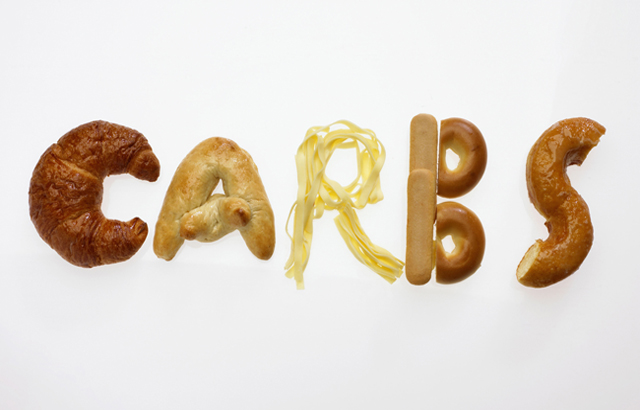Good carbs, bad carbs. High glycemic, low glycemic. Simple or complex. High carb, low carb, Paleo, Mediterranean, Atkins. When it comes to carbohydrates, sugars, diet and nutrition, it seems as if it is anything but simple.
Let’s see if we can make some sense out of all the nonsense.
Carbohydrates are one of three types of macronutrients in the human diet. The other two macronutrients are fats and proteins. All foods that we consume are comprised of at least one, usually two, and rarely all three, macronutrients.
Let’s set the record straight, right out of the blocks. By definition, ALL carbohydrates are sugars. The only differences lie in the complexity of the chains of sugars. The following is a sample list of foods that are primarily carbohydrates:
- Breads, cereals, grains and pastas
- Fruits
- Vegetables
- Most junk food
- Most sports drinks
- Beer & wine
Simple vs. Complex Carbohydrates
Simple carbohydrates are sugars made up of just one or two sugar molecules. Complex carbohydrates, on the other hand, consist of many sugar molecules linked together into chains.
The simplest sugar is glucose. Glucose is the elemental sugar that virtually every cell in the body burns for energy. Even proteins and most fats need to get converted to glucose (a process called gluconeogenesis) before they can be used for fuel.
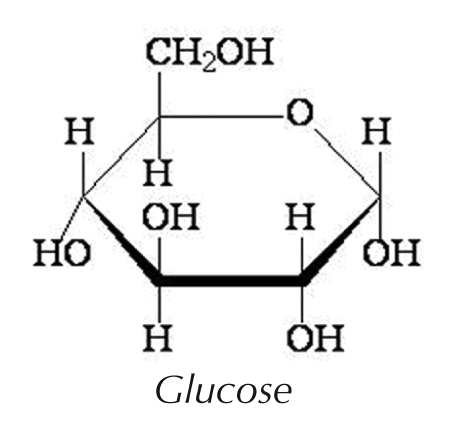
Chemical structure of glucose
Fructose is the sugar found most commonly in fruit. (This is not to be confused with high fructose corn syrup, which is a chemically derived artificial sweetener almost twice as sweet as glucose.)
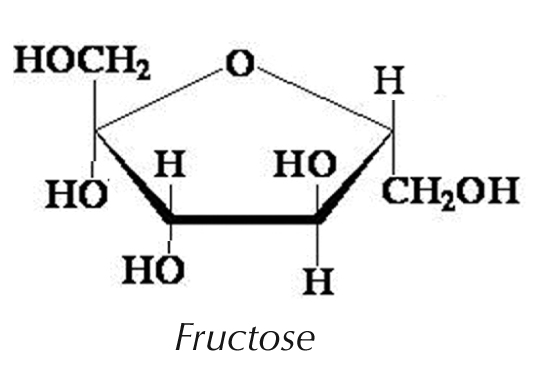
Chemical structure of fructose
Sucrose is common table sugar. It is a simple carbohydrate made up of one molecule of glucose linked to one molecule of fructose.
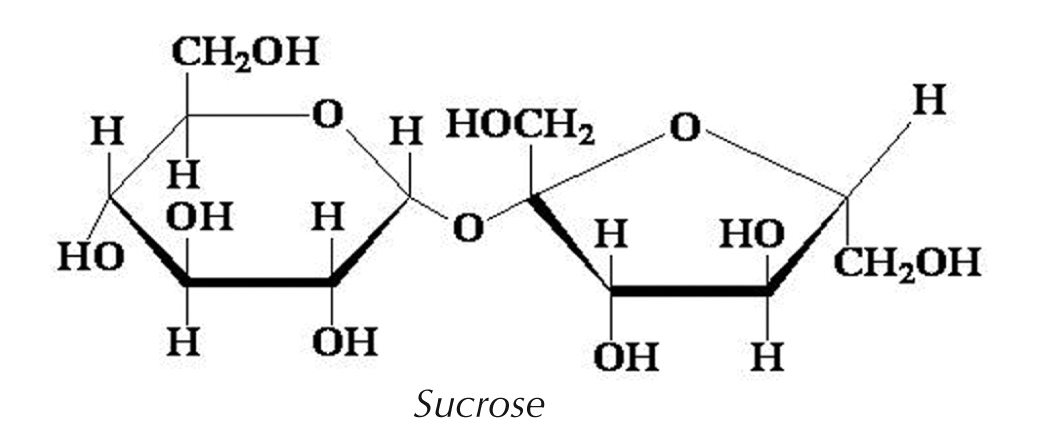
Chemical structure of table sugar, sucrose
Now look at the structure of amylopectin, the main sugar in starch.
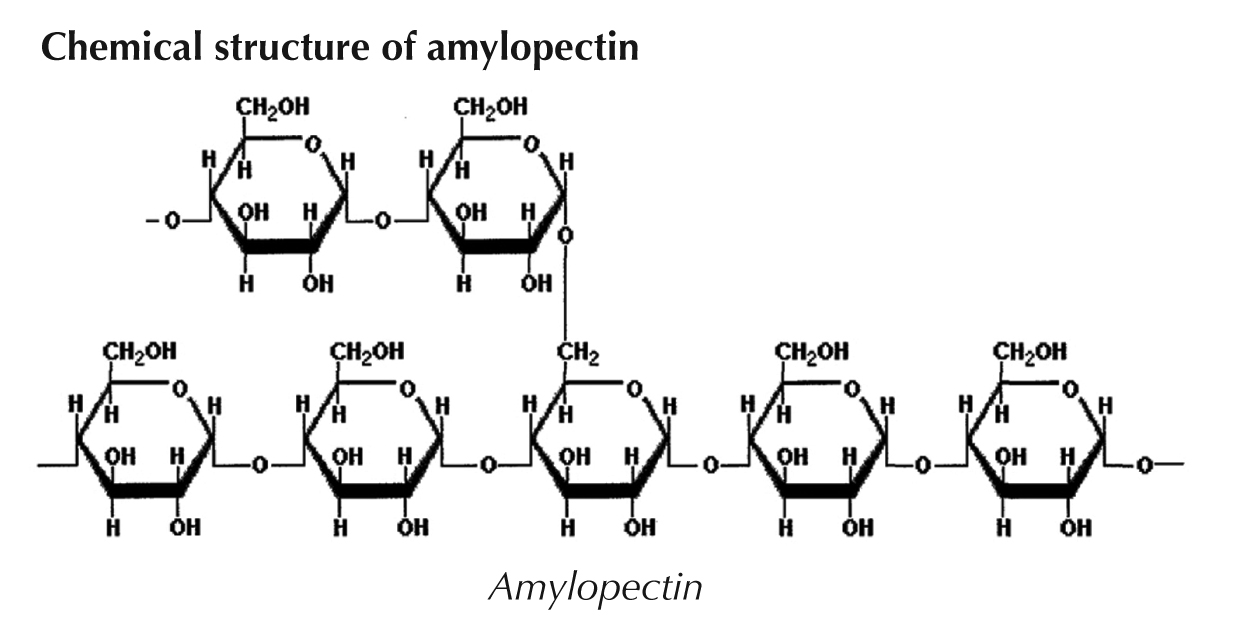
Chemical structure of amylopectin
Note that amylopectin is just a very long chain of glucose molecules linked together, with additional side chains also made up of glucose. The side chains branch off after every 30 or so glucose molecules. And the side chains themselves contain an average of 30 glucose molecules each. In all, amylopectin molecules may contain up to two million glucose units! This is a perfect example of a very complex carbohydrate!
So What’s the Difference?
Why is it important to know the difference between simple and complex carbohydrates? This is where the glycemic index comes into play.
The glycemic index is a measure of how fast various carbohydrates break down and raise blood sugar. Carbs that are quickly digested and release glucose into the blood stream rapidly have a high glycemic index. Carbs that take longer to digest, and that therefore raise blood sugar more slowly, are said to be low glycemic.
The body responds to elevated blood sugar levels by releasing the hormone insulin from the pancreas to help metabolize the sugars and reduce blood sugar levels. This is because high blood sugar levels are potentially very damaging and dangerous to the body. The rate at which insulin is released is largely dictated by how fast blood sugar levels rise. The faster the rise in blood sugar (due to high glycemic carbs), the faster the rise of insulin levels.
Now here’s the rub. While insulin is largely responsible for lowering blood sugar, it is also the main fat storage hormone! As insulin levels rise, the machinery that stores fat gets turned on in direct relation. Higher insulin levels mean greater fat storage. Type 2 diabetes is a problem of too much insulin production (largely due to what’s known as insulin resistance). What do most Type 2 diabetics look like? That’s right, they’re overweight! Too much insulin means too much fat storage.
So, as you can guess, simple carbs, most of which are very low glycemic, stimulate rapid and large insulin secretions, while complex carbs, which take longer to break down and digest, cause a much slower and gradual rise in insulin.
The “Good” and “Bad” of Carbs
No naturally occurring carbohydrate, whether simple or complex, is inherently “good” or “bad.” Everything that God created is, in its natural state, healthy. The problems arise when we:
- Consume too many simple carbohydrates
- Consume too many complex carbohydrates
- Scientifically chemically alter the natural sugars
Before the advent of modern food production and processing, people ate only what was grown in a particular season, and the food itself was not subject to processing or manipulation. White sugar and flour didn’t exist. Preservatives didn’t exist. Genetically modified wheat didn’t exist. Refrigeration didn’t exist. And “super sizing” didn’t exist! No surprise—obesity, diabetes, arthritis, heart disease, Alzheimer’s disease, and many other degenerative and inflammatory conditions were rare.
It should be obvious at this point what happens when we eat too many simple carbs. A diet of simple sugars and junk food causes persistently high insulin levels that, over time, will wreak havoc on the body, potentially causing Type 2 diabetes, obesity, high blood pressure, cholesterol problems, heart disease, gout, and other inflammatory and degenerative conditions.
In 1905 the average North American consumed 5 pounds of sugar per person each year. By 2009 that amount skyrocketed to 150 pounds of sugar per person each year, with 63 pounds of that alone being high fructose corn syrup! Most evidence now points to increased sugar intake as the cause of our obesity epidemic, heart disease, and other health problems, not fat consumption.
Special mention needs to be made here about fruit. While fruit naturally contains the simple sugar fructose, there is relatively little fructose in one piece of fruit. For example, a medium sized orange contains about 6 grams of fructose. But an 8 ounce glass of orange juice has over 14 grams of fructose!
In addition, the fruit, when eaten whole, has lots of natural fiber. The fiber significantly slows the release of the sugar into the blood stream. That glass of orange juice has no fiber (pulp doesn’t count!). So the entire fructose load gets dumped into the blood stream, overwhelming the body’s ability to metabolize it.
Getting back to our ancestors, most of the carbohydrates they ate were both very complex and also extremely high in fiber. It has been estimated that 200 years ago the average person consumed 200-300 grams of fiber a day. Today the average is 20-30 grams! Fiber, as noted above with fruit, drastically slows the digestion of the carbohydrates, allowing the body to process the released sugars in a healthy way.
But eating too many complex carbohydrates can also be a bad thing! Here it’s more an issue of portion control. (Note that I did NOT say “calorie control.” The whole “calories in, calories out” argument is fallacious. But that’s a topic for another article.) Eating too many complex carbs, while causing a much slower insulin response, will still end up with persistently high insulin levels and the health derangements that accompany it.
Scientifically Altered Sugars
We all know that simple sugars are bad for us. But how exactly is white sugar made? The answer is important, as we’ll see when talking about other sugars.
White sugar comes from the natural sugar cane plant. Sugar cane, in its raw and native form, is considered a whole food. It is brimming with vitamins, minerals, enzymes, antioxidants, phytonutrients, and fiber. It’s actually nourishing! When eaten as a whole package, raw sugar cane is a very low glycemic food.
Raw sugar cane is passed through giant press rollers that squeeze the juice out. The juice, which contains dirt and fibers from the cane, is collected in large tanks. From there it gets “cleansed” to remove the dirt & debris, by getting treated with calcium hydroxide—slaked lime. (Calcium hydroxide is also used in water and sewage treatment plants.) The juice is then heated to evaporate the water, leaving a dark syrup that, at this point, still has lots of nutrients and antioxidants.
Next the juice is boiled to remove the rest of the water. But in the process, all of the natural enzymes and many of the nutrients are destroyed by the heat. As the water is boiled off small sucrose crystals are added to initiate the “seeding.” This starts the crystallization process.
The crystals are “purified,” first by mixing them with a heavy syrup then heating it to dissolve the outer part of the crystal (containing the last bit of nutrients) but not the inner part. The remaining crystals are separated from the syrup by centrifuge, after which they are again “purified” by melting and mixing again with slaked lime. The clarified syrup is decolorized by passing it through charcoal filters, boiled again and repeatedly crystallized and centrifuged to produce white sugar.
Raw sugar cane, containing only 15% sucrose and lots of nutrients, ends up as table sugar containing 99.8% pure sucrose and NO nutrients! Oh, by the way, sugar made from sugar beets ends up the same—essentially the same process minus a few steps.
So we head to the store and buy “Sugar in the Raw,” organic raw sugar, or turbinado, thinking that we’re being health conscious. But they basically all go through the same process as white sugar, with varying amounts of molasses added back to produce sugars of various brown colors. They are clever products of marketing, but they are absolutely no better for you than the “white death” of table sugar.
Pink, Blue, and Yellow Packets
Saccharine (Sweet’N Low®) was accidentally discovered in 1879. A German chemist was working on making new products from toluene, a hazardous liquid derived from making tar from coal, and used in making gasoline and paint thinner. He accidentally spilled some new clear liquid on his hands, and later that night at dinner noticed that his food tasted sweet. Thus saccharine was borne! In 1977 the FDA proposed a ban on it. In 1981 saccharine was listed by both the U.S. and Canadian governments as a human carcinogen. But in 2000 Congress intervened and removed warning notices from saccharine.
Aspartame (Equal® and others) was “discovered” in 1965 during experiments to find a new drug to treat ulcers. Some bubbling liquid spilled over the edge of a beaker onto the chemist’s hand. Later, when he licked his finger to pick up a piece of paper, he too noticed an oddly sweet taste, and aspartame was created. The FDA once listed over 92 different symptoms linked to the use of aspartame, but under pressure from Congress (who was getting heavily lobbied), the FDA backed off.
Sucralose (Splenda®) has since become the darling of alternative sweeteners. But its path to glory is also clouded. A British chemist of Indian origin was working on ways to use sugar to create new insecticides. Due to difficulty translating English, the chemist thought he was told to “taste” the new product, when in reality he had been told to “test” the product! He liked the sweet taste, and sucralose was thus invented.
While Splenda is marketed as being “natural” because it comes from sugar, that’s only a partial truth. Sucralose does not exist in nature. Sucrose undergoes a 5-step process involving many caustic chemicals that substitutes several harmful chlorine atoms. The manufacturers claim the chlorine is no more harmful than the chlorine in table salt (sodium chloride). Naturally occurring chlorine can be beneficial, but artificial chlorine is potentially dangerous.
Other Unhealthy Sugars
By now most of us are aware of the dangers of high fructose corn syrup. But other sugars are also far from ideal. The current poster child for healthy sugar alternatives is agave. Agave is a highly processed sweetener with even more fructose than high fructose corn syrup! Agave production is similar to how white corn starch gets converted to high fructose corn syrup. But agave can contain up to 90% fructose, almost all of which gets converted to fat!
Truvia has also become popular as a sugar substitute. Rather than the product of experimental errors, Truvia was intentionally designed. While it begins with the leaf of the stevia plant (see below), the stevia is “refined” to remove the component that causes the characteristic aftertaste of stevia. The resulting purified product does not exist in the native stevia plant, or anywhere in nature for that matter.
Healthy Sugars
While a complete list is beyond the scope of this article, two of the best sugar alternatives are stevia and raw organic sugar cane.
Stevia is derived from the leaf of the stevia plant. As such it is actually an herb, not a sugar. It was discovered in 1899, and over 500 scientific studies have been done showing its benefits:
- Can help regulate blood sugar levels
- Can help in weight reduction (stevia has no calories)
- Can inhibit the growth of oral bacteria
- When applied to skin, can help heal cuts and improve eczema and acne
- Contains inulin, a natural soluble fiber that can aid digestion
But buyer beware. Not all products marketed as “stevia” are the same. Some, marketed as “stevia extract,” contain added sugar, such as maltodextrose. The ingredients should list only inulin and stevia extract, nothing else.
Raw, unrefined whole organic sugar cane is as close as you can get to the original sugar cane without actually gnawing on the cane itself! It is a coarse granular crystal, medium brown in color. Like white sugar, the cane is pressed and the juice is collected. But the juice is heated over a low heat (thereby preserving the integrity of the nutrients) to create a syrup, being stirred gently with paddles. Crystals form naturally as the water evaporates. The crystals are ground in a sieve, producing a coarse, brown grainy sugar that retains almost all of the health benefits of the original cane.
Again, beware of the tactics of unscrupulous marketers. “Evaporated cane juice” and “evaporated cane sugar” are NOT the same as raw organic cane sugar. They are no better than refined white sugar.
Summary
Carbohydrates form an essential part of a healthy diet. But the nature and amount of carbs need to be carefully considered. We should try our best to eliminate as much refined sugar and dangerous sugar substitutes from our diets as possible, and we should choose healthier complex carbs instead.
Healthy carbs include:
- Quinoa
- Spelt
- Buckwheat
- Whole wheat (preferably non-GMO)
- Millet
- Steel-cut oats
- Rye
- Brown rice
Don’t forget that all vegetables and fruits are also carbohydrates. Choosing green leafy and brightly colored vegetables over the more starchy ones is a better strategy overall. And choosing fruits that are naturally lower in sugar and higher in fiber, such as berries, is also a wiser choice.
What we eat with our carbohydrates is also important. Looking to nature for guidance on food combinations, we see that carbohydrates are naturally paired with proteins (beans, legumes), but rarely with fats. Likewise, fats are commonly bound with proteins (animal meats, fish, eggs, cheese), but rarely with carbohydrates.
So a general dietary principle is to have meals that combine either protein and carbs or protein and fats, but limit those meals that combine carbs and fat. Remember that ALL carbohydrates raise insulin, and insulin increases the fat storage machinery.
Also, eat smaller meals more frequently, rather than a few large meals. This keeps insulin levels lower, leading to better weight control and better health.
Paul D. Tortland, D.O.
